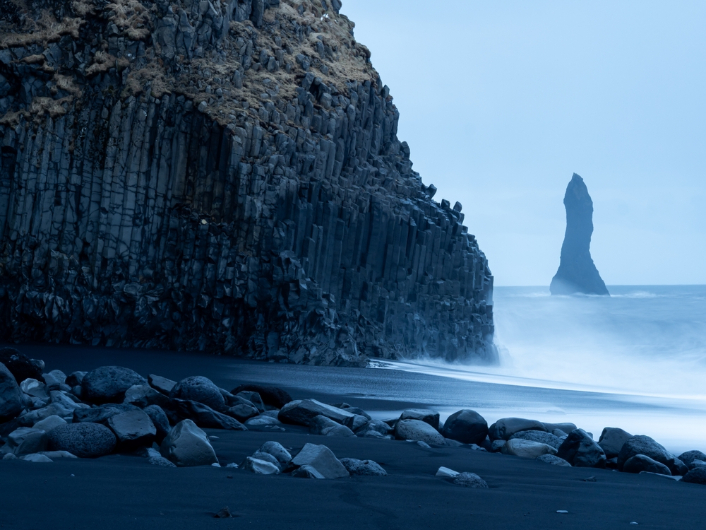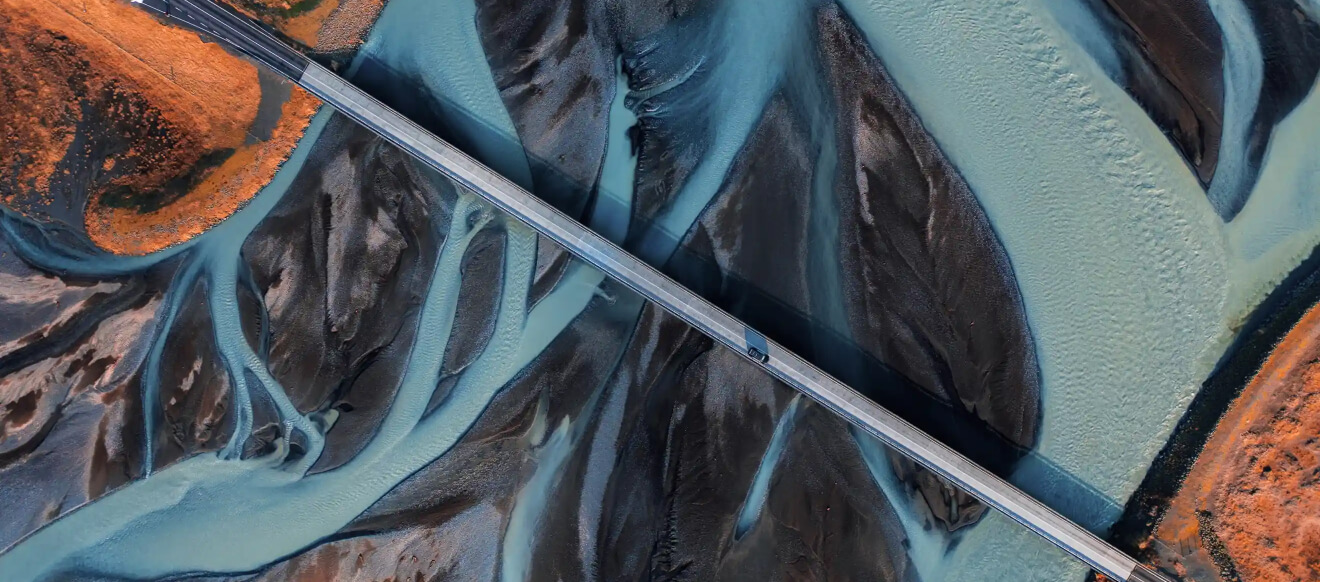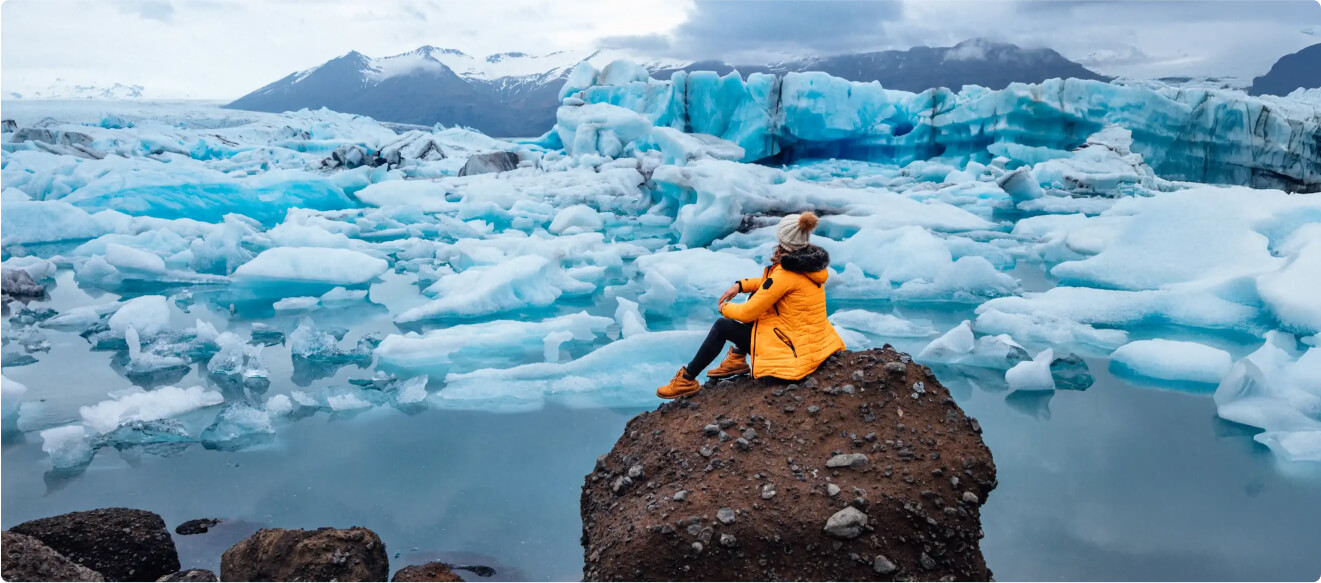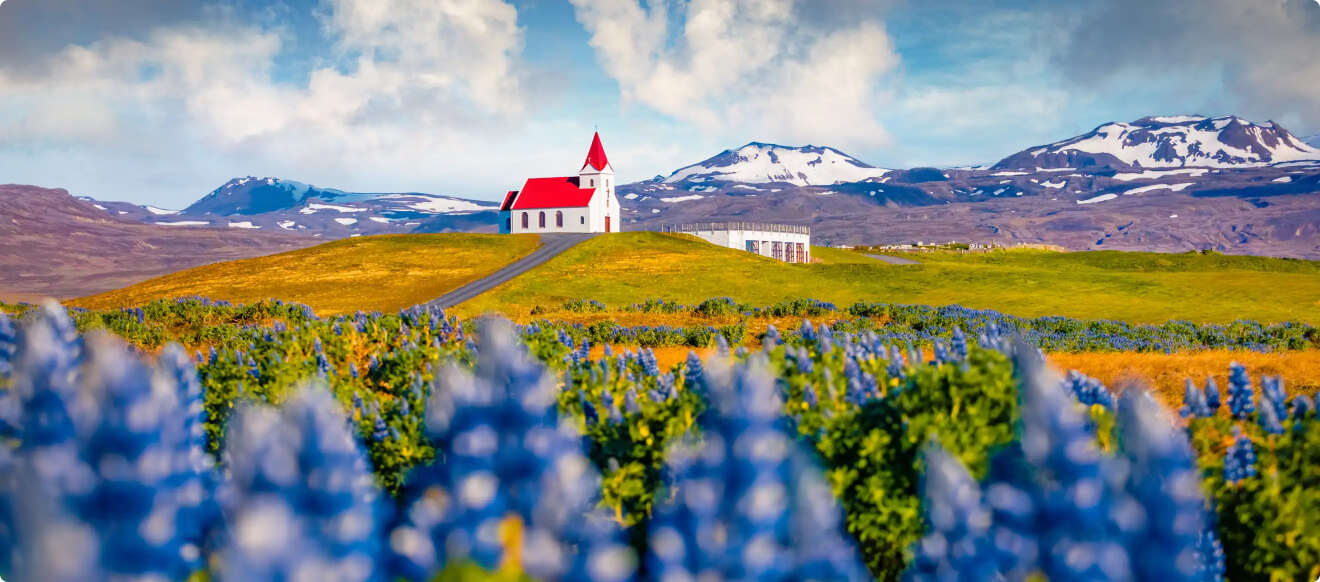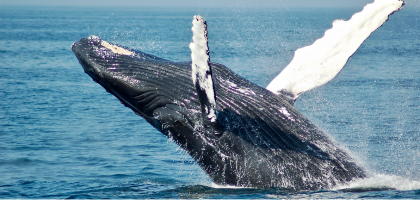Iceland has one of the most unique landscapes in the world. The fiery wrath of the island’s volcanoes mixed with the landshaping movement of icy glaciers has created dramatic, breathtaking scenery. It’s every geology lover’s dream.
And basalt columns in Iceland are one of the country's natural wonders that you absolutely have to check out. There are dozens of places where you can view these magnificent rock formations in diverse and various forms.
An Intro to Iceland Geology
Iceland is known as the Land of Fire and Ice due to the contrasting elements present on the island. We are located far up in the North Atlantic Ocean close to the Arctic Circle, so the country has several glaciers. At the same time, we rest on the plate boundary of the North American and Eurasian tectonic plates.
This creates our own version of the Ring of Fire and it means we have a lot of volcanic activity. This unexpected combination makes for a mix of natural forces that you won't find anywhere else on the planet.
Iceland basalt columns: How they are formed
Basalt is a volcanic rock formed from the superheated magma that emerges as lava during an eruption. Hexagonal basalt rocks form as lava cools and contracts, creating shapes that minimize stress and surface area, with hexagons being the most efficient pattern.
The iron and magnesium-rich basalt lava cools and contracts very quickly once exposed to the surface air, and hardens as it solidifies. Basalt structures vary from glassy to fine-grained. Commonly, they show a porphyritic texture with large crystals of olivine, augite, or feldspar in a fine matrix.
Iceland's basalt columns are the result of this rapid cooling process that changes the chemical makeup and appearance of the lava. Basalt typically appears dark gray to black, due to high pyroxene content, but varies in shade, with light-colored basalt, called leucobasalt, containing more plagioclase.
Basalt volcanic rock has a special geometrical shape due to this change in composition. In volcanic rocks, straight and regular columnar fractures are known as a colonnade, while the more irregular ones are referred to as an entablature.
Where does basalt form?
Basalt forms from cooling lava, common at rifts like Iceland, the East African Rift, the Red Sea, and New Mexico and Colorado's Rio Grande Valley.
Basalt columns form when lava cools, contracts, and fractures into geometric shapes. These basalt pillars and hexagonal rock formations you see have a special feature called columnar jointing. This is what gives each basalt column their unmistakable hexagonal shape and makes them so neat to look at. Columnar jointing has also been found in planets like Mars.
It's the same natural process that gives the Giant's Causeway in Ireland its rugged appearance. These basalt columns are also the result of an ancient volcanic fissure eruption.
The geological wonder of basalt rocks has even inspired Icelandic architecture. You can see Mother Nature’s influence in the facades of buildings like Hallgrímskirkja church in Reykjavik and Akureyrarkirkja in Akureyri. While some think they are meant to look like the organ inside, they're actually supposed to be reminiscent of a rock formation. The architect wanted to recreate the look of Iceland basalt columns on the front sides of these imposing buildings.
Hexagonal rock formations and basalt pillars: Where to see them in Iceland
You'll find basalt rock formations all over Iceland due to the high amounts a volcanic activity that we experience. We truly are a country whose landscape is shaped by natural elements. These are some of the best places to see our unique geology and Iceland hexagonal rocks.
Svartifoss: The black basalt column waterfall
Iceland is known for the breathtaking beauty of its waterfalls. In fact, the country has over 10,000 cascades. One of our most spectacular is the Svartifoss waterfall, located in the Skaftafell section of Vatnajökull national park. It's known as Iceland's black waterfall not because of the color of its water, but rather the dark basalt pillars that make up the cliff face.
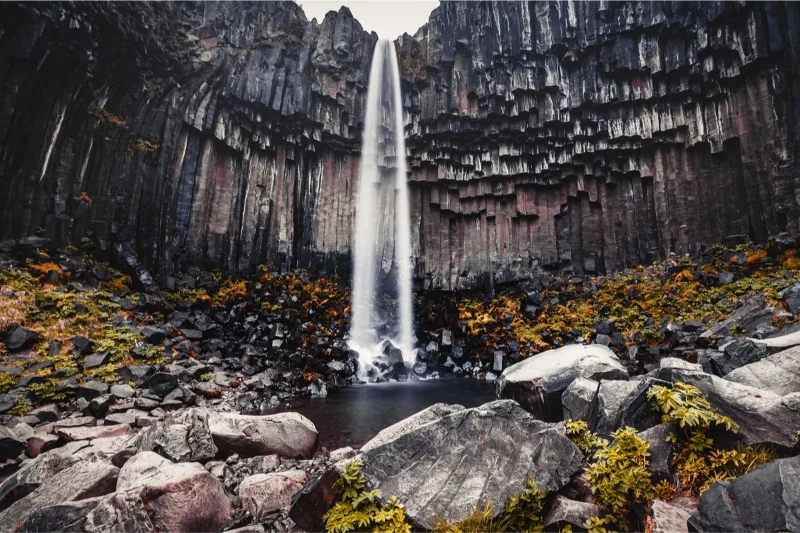
The columns look as though they are precariously hanging like some large, natural pipe organ that could drop at any moment. You'll notice that some of the basalt column formations have broken off and fallen to the ground below.
When making your way along the South Coast in your Iceland car rental, Svartifoss is an easy detour from the Ring Road.
The basalt columns at Reynisfjara beach
While many countries are famed for their tropical beaches, that's not the case with Iceland. Instead, we are known for our black beaches filled with dark volcanic sand. Reynisfjara beach is perhaps one of our most popular attractions, and for good reason.
It not only has the black sand beaches that Iceland is so famous for. It also features basalt rock formations with some pretty spectacular terrain and sweeping panoramic views. Iceland's Reynisfjara, near Vik on the South Coast, is well-known for its black sand beach and distinctive basalt columns, a key highlight of the region. As one of the best basalt column places in Iceland, it's no wonder Game of Thrones producers chose it as a filming location.
The sea stacks and basalt columns of the Reynisfjara black sand beach are probably some of the most photographed rock formations in the world. They are a beautiful, highly unusual geological phenomenon that you really won't find anywhere else in the world. The unique combination of the hexagonal basalt columns set against the backdrop of black volcanic sand makes for quite a sight.
Reynisfjara Beach's basalt columns in Iceland were formed when lava from a volcano met the sea, rapidly cooling into hexagonal shapes. The beach is also known for its distinctive black sand.
You'll actually find two points of interest along the shoreline here. The first is the basalt rocks on the cliffs close to the water. The second is the group of tall Iceland rocks of the Reynisdrangar basalt sea stacks just off the shore.
Many tour companies offer guided tours to black sand beaches and basalt columns locations that allow you to learn about the geological history of these unique features while taking in their breathtaking beauty. Whether you're a geology enthusiast or just looking for an unforgettable adventure, these tours can be a great option when visiting Iceland's south coast.
Iceland hexagonal rocks at the Gerðuberg basalt column cliff
Along Snaefellsvegur road in the Snaefellsness (Snæfellsnes) peninsula, you'll pass one of the most massive examples of basalt columns in Iceland. You can actually see the basalt column cliff from the roadside as you drive towards Snaefellsjökull. The Gerðuberg basalt column cliff is made up of hundreds of basalt column stacks.
Be careful not to be distracted by this fascinating sight. Find a place to pull over so that you can get out to take pictures and see these Iceland hexagonal rocks up close.
The stunning Stuðlagil canyon in Jökuldalur
This is definitely one of the most picturesque places you'll encounter in Iceland and you definitely want to bring your camera with you. You'll be hypnotized by the turquoise blue river surrounded by a fortress of basalt pillars on not one, but two sides. This newly discovered treasure of Iceland geology is a feast for the eyes and will leave you speechless. Much like with the Northern Lights, it's amazing to think that something like this was completely created in nature.
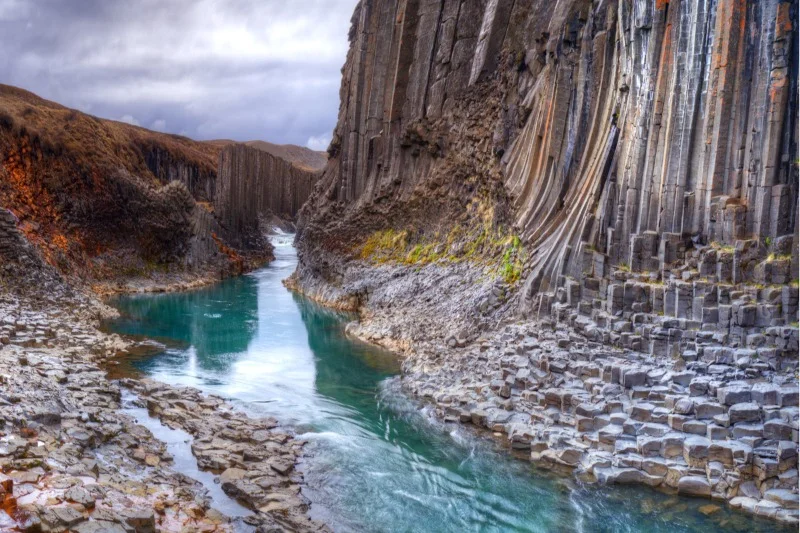
The walking trail between Arnarstapi and Hellnar
Another great place to see this naturally occurring geological formation is along the hiking trail from Arnarstapi to Hellnar. These two quaint fishing villages on the Snaefellsnes peninsula are a common overnight stop-off point for travelers exploring the area in depth.
Many visitors walk the path between the two villages in order to observe the seaside column formations. There are also many seabirds along the cliffs and it makes for a really lovely, non-strenuous hike in the evening.
kirkjugolf
Kirkjugólf in South Iceland, known as "the church floor," is a distinctive basalt column formation in the town of Kirkjubæjarklaustur. Spanning around 80 square meters, it features hexagonally shaped stones that closely resemble a patterned, man-made floor, often likened to that of a church. This misperception led to its name, which translates to "church floor" in Icelandic, although it's purely a natural formation.
Despite myths suggesting an ancient church once stood there, Kirkjugólf is entirely made of natural basalt stones, formed by cooling lava that contracted into these unique shapes. Its location near Stjóranarfoss waterfall makes it easily accessible, with a brief walk from a nearby parking area. Visitors should note the absence of restroom facilities in the vicinity.
Stuðlafoss: Another basalt column waterfall
Stuðlafoss is another basalt column stack waterfall, similar to Svartifoss. It's a recently discovered and therefore lesser-known Icelandic highlight close to the hidden Stuðlagil canyon in Jökuldalur valley.
The waterfall, canyon, and valley are all closed to the Ring Road, so visiting the unparalleled rugged beauty of Stuðlafoss is easy. Be one of the first to explore this geological gem in East Iceland.
More stunning basalt Iceland waterfalls: Aldeyjarfoss
The mighty Aldeyjarfoss waterfall is another cascade featuring basalt rock. But it looks completely different than either Svartifoss or Stuðlafoss. The former falls feature a cliff face made entirely of hexagonal rocks. Aldeyjarfoss, by contrast, has two types of Iceland rocks along its craggy surface.
This creates an interesting visual effect and it's not something you will find in many places. Additionally, the strong, gushing flows of the glacial river that feed this waterfall add to its power and majesty.
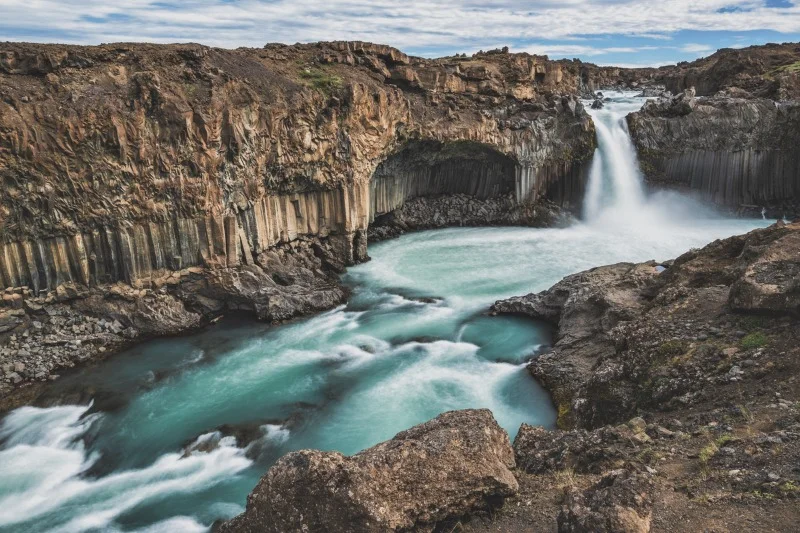
Hljóðaklettar (Echo Cliffs)
Hljóðaklettar, much like Gerðuberg, is another Icelandic cliff made from basalt rocks. This particular cliff shares the same characteristics as Aldeyjarfoss in that it has columns topped by an uneven surface of more rock.
Something distinctive about this geological attraction is that much of the basalt has broken off. This gives it the interesting appearance of a rock quarry with stones just waiting to be hauled away.
Kálfshamarsvík: A small cove with columns underfoot
While the majority of Iceland's hexagonal basalt columns are vertical, there are a few horizontal specimens. At Kálfshamarsvík bay in North Iceland, you'll find a cove with long, hexagonal basalt columns that you can walk on.
Much like on the path between Arnarstapi and Hellnar, horizontal rocks jut out into the water. They make for a sort of volcanic, naturally-occurring cobblestone that has a really cool effect.
Basalt columns in Iceland
I hope you have time to stop and see some of the spectacular sights and impressive basalt column attractions during your road trip. Iceland is a geological wonderland and the abundance of natural beauty with which we are blessed will leave you in awe.
Be sure to check out some of our most famous hexagonal rock formations and take plenty of pictures of Iceland's geology at its finest.




